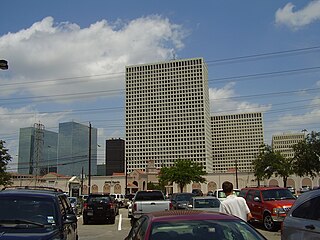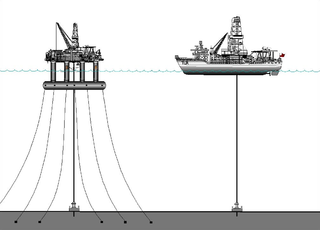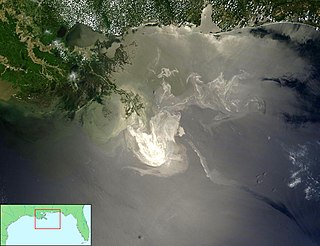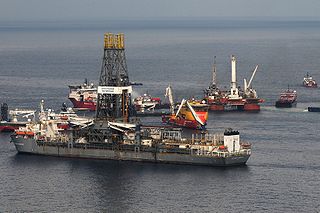
Transocean Ltd. is the world's largest offshore drilling contractor based on revenue and is based in Vernier, Switzerland. The company has offices in 20 countries, including Canada, the United States, Norway, Scotland, India, Brazil, Singapore, Indonesia, and Malaysia.

A drillship is a merchant vessel designed for use in exploratory offshore drilling of new oil and gas wells or for scientific drilling purposes. In most recent years the vessels are used in deepwater and ultra-deepwater applications, equipped with the latest and most advanced dynamic positioning systems.

Deepwater Horizon was an ultra-deepwater (35,000 ft [11,000 m]), dynamically positioned, semi-submersible offshore drilling rig owned by Transocean. Built in 2001 in South Korea by Hyundai Heavy Industries, the rig was commissioned by R&B Falcon, registered in Majuro, and leased to BP from 2001 until September 2013. In September 2009, the rig drilled the deepest oil well in history at a vertical depth of 35,050 ft (10,683 m) and measured depth of 35,055 ft (10,685 m) in the Tiber Oil Field at Keathley Canyon block 102, approximately 250 miles (400 km) southeast of Houston, in 4,132 feet (1,259 m) of water.
Deepwater Millennium was a fifth generation Samsung/Reading & Bates designed, dynamic positioned (DP) Marshall Islands-flagged drillship owned by Transocean. The vessel was capable of drilling in water depths up to 8,100 ft using an 18.75 in (47.6 cm), 15,000 psi blowout preventer (BOP), and a 21 in (53 cm) outside diameter (OD) marine riser. It was retired in 2018.
Transocean Marianas is an Earl & Wright Sedco 700 design semi-submersible platform drilling unit capable of operating in harsh environments and water depths up to 7,000 feet (2,100 m) using an 47.6 cm (18.75 in), 15,000 psi blowout preventer (BOP), and a 53 cm (21 in) outside diameter (OD) marine riser.

The Tiber Oil Field is a deepwater offshore oil field located in the Keathley Canyon block 102 of the United States sector of the Gulf of Mexico. The deepwater field was discovered in September 2009 and it is operated by BP. Described as a "giant" find, it is estimated to contain 4 to 6 billion barrels of oil in place. Although BP states it is too early to be sure of the size – a "huge" field is usually considered to contain 250 million barrels. It required the drilling of a 10,685 m (35,056 ft) deep well under 1,260 m (4,130 ft) of water, making it one of the deepest wells ever drilled at the time of discovery.

The FPSO Noble Seillean was a dynamically positioned floating oil production, storage and offloading vessel.

Q4000 is a multi-purpose oil field construction and intervention vessel ordered in 1999 by Cal Dive International, and was built at the Keppel AmFELS shipyard in Brownsville, Texas for $180 million. She was delivered in 2002 and operates under the flag of the United States. She is operated by Helix Energy Solutions Group. The original Q4000 concept was conceived and is owned by SPD/McClure. The design was later modified by Bennett Offshore, which was selected to develop both the basic and detailed design.

The Deepwater Horizon oil spill was an industrial disaster that began on April 20, 2010, in the Gulf of Mexico on the BP-operated Macondo Prospect, considered to be the largest marine oil spill in the history of the petroleum industry and estimated to be 8 percent to 31 percent larger in volume than the previous largest, the Ixtoc I oil spill, also in the Gulf of Mexico. The U.S. federal government estimated the total discharge at 4.9 million barrels. After several failed efforts to contain the flow, the well was declared sealed on September 19, 2010. Reports in early 2012 indicated that the well site was still leaking. The Deepwater Horizon oil spill is regarded as one of the largest environmental disasters in American history.

The Macondo Prospect is an oil and gas prospect in the United States Exclusive Economic Zone of the Gulf of Mexico, off the coast of Louisiana. The prospect was the site of the Deepwater Horizon drilling rig explosion in April 2010 that led to a major oil spill in the region.

The Deepwater Horizon drilling rig explosion was the April 20, 2010, explosion and subsequent fire on the Deepwater Horizon semi-submersible Mobile Offshore Drilling Unit (MODU), which was owned and operated by Transocean and drilling for BP in the Macondo Prospect oil field about 40 miles (64 km) southeast off the Louisiana coast. The explosion and subsequent fire resulted in the sinking of the Deepwater Horizon and the deaths of 11 workers; 17 others were injured. The same blowout that caused the explosion also caused an oil well fire and a massive offshore oil spill in the Gulf of Mexico, considered the largest accidental marine oil spill in the world, and the largest environmental disaster in U.S. history.
Deepwater Discovery was a Samsung/Reading & Bates designed, fifth generation, deepwater dynamic positioning Vanuatu-flagged drillship owned and operated by Transocean. The vessel was capable of drilling in water depths up to 3,049 m using an 18.75 in (47.6 cm), 15,000 psi blowout preventer (BOP), and a 21 in (53 cm) outside diameter (OD) marine riser. It was retired in 2018.
The following is a timeline of the Deepwater Horizon oil spill. It was a massive oil spill in the Gulf of Mexico, the largest offshore spill in U.S. history. It was a result of the well blowout that began with the Deepwater Horizon drilling rig explosion on April 20, 2010.

Discoverer Enterprise is a fifth generation deepwater double hulled dynamically positioned drillship owned and operated by Transocean Offshore Deepwater Drilling Inc., capable of operating in moderate environments and water depths up to 3,049 m (10,000 ft) using an 18.75 in (47.6 cm), 15,000 psi blowout preventer (BOP), and a 21 in (53 cm) outside diameter (OD) marine riser. From 1998 to 2005 the vessel was Panama-flagged and currently flies the flag of convenience of the Marshall Islands.

GSF Development Driller II is a fifth generation, Vanuatu-flagged dynamic positioning semi-submersible ultra-deepwater drilling rig owned and operated by Transocean. The vessel is capable of drilling in water depths up to 7,500 ft (2,300 m) with drilling depth of 35,000 ft (11,000 m), upgradeable to 37,500 ft (11,400 m).

Deepwater Nautilus is an ultra-deepwater, semi-submersible offshore drilling rig.
Following is a timeline of the Deepwater Horizon oil spill for June 2010.
Following is a Timeline of the Deepwater Horizon oil spill for May 2010.
Efforts to stem the Deepwater Horizon oil spill were ongoing from the time that the Deepwater Horizon exploded on 4/20/2010 until the well was sealed by a cap on July 15, 2010. Various species of dolphins and other mammals, birds, and the endangered sea turtles have been killed either directly or indirectly by the oil spill. The Deepwater Horizon spill has surpassed in volume the 1989 Exxon Valdez oil spill as the largest ever to originate in U.S.-controlled waters; it is comparable to the 1979 Ixtoc I oil spill in total volume released.
The Deepwater Horizon investigation included several investigations and commissions, among others reports by National Incident Commander Thad Allen, United States Coast Guard, National Commission on the BP Deepwater Horizon Oil Spill and Offshore Drilling, Bureau of Ocean Energy Management, Regulation and Enforcement, National Academy of Engineering, National Research Council, Government Accountability Office, National Oil Spill Commission, and Chemical Safety and Hazard Investigation Board.












